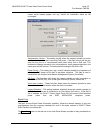
PANDUIT® DPoE™ Power Patch Panel User’s Guide Issue 2.2
Part Number: PN378A
35
panels wired in a single rack will be displayed consistent with the value in the Rack
Space Position field. (See page 29, Provisioning the Panel, for more information.)
Once these values are set in the EM, this information will be transmitted and stored
in the
DPoE™ Power Patch Panels.
Two additional fields are available on this screen and affect the operation of the
panel. The first field, the Power Threshold
, allows the network operator to configure
the available power for this panel as a percentage of the maximum power the panel
can support. For example, although the panel can support 480 watts, panels that
use external power supplies, rather than a direct 48-volt input, are not normally
capable of supplying 480 watts of power. Therefore, the Power Threshold
for this
panel might be set at 30%. And the Power Warning Threshold, which tells the panel
when to send an alarm messages, might be set at 10%, so that the panel starts
alarming when it reaches 90% of this particular panel's maximum. (See page 47,
EM Log Messages, for more information on Power Warning Threshold.)
The Enable Trap
is a checkbox ( ) to quickly turn on/off an individual panel’s
reporting of threshold power alarms.
− SNMP Settings
The system defaults to public for the SNMP Read Community
and private for the
SNMP Write Community
.
IMPORTANT:
The SNMP Community fields are case-sensitive and allow
SNMP messages to be exchanged between the EM and the
DPoE™ Power Patch Panels.
FOR SECURITY REASONS, THESE FIELDS SHOULD BE
CHANGED FROM THEIR DEFAULTS.
− Trap Settings
The Trap Setting section allows the network operator to configure the
DPoE™
Power Patch Panel to send configuration and alarm messages to up to three
different IP addresses.
IMPORTANT:
One of the Traps must be configured and set to the IP address
of the computer running the EM in order for the EM to receive
configuration and alarm messages from the panel
.
The computer running the EM should not have any other
programs running that receive trap information.
The IP Address
, SNMP Community String and SNMP version (normally SNMP V2C)
are set according to the destination device for these outgoing messages. The
Enable
provides an easy on/off button for the traps without having the delete the
above-entered information.
The other fields, Critical
, Major, Minor, Advisory, refer to the priority of the messages
and allow the network operator to designate which message should be sent to each
trap. (See page 47,
EM Log Messages, for more information.)


















